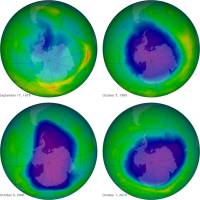The ozone layer that shields life from cancer-causing solar rays is showing its first sign of recovery after years of dangerous depletion, a U.N. study said on Wednesday, in a rare piece of good news on the environment.
Experts said it was largely down to global action — a 1987 ban on man-made gases that damage the fragile high-altitude screen. The agreement would help prevent millions of cases of skin cancer and other conditions, they added.
The ozone hole that appears over Antarctica has also stopped growing bigger every year, though it will be about a decade before it starts shrinking, said the report co-produced by the World Meteorological Organization and the U.N. Environment Programme.
"International action on the ozone layer is a major environmental success story. ... This should encourage us to display the same level of urgency and unity to tackle the even greater challenge of tackling climate change," said WMO Secretary-General Michel Jarraud.
Past studies have suggested the ozone layer has stopped getting worse.
"Now for the first time in this report we say that we see indications of a small increase in total ozone. That means recovery of the ozone layer in terms of total ozone has just started," said WMO senior scientific officer Geir Braathen.
The 1987 Montreal Protocol that banned or phased out ozone depleting chemicals, including chlorofluorocarbons (CFCs) once widely used in refrigerators and spray cans, would prevent 2 million cases of skin cancer annually by 2030 according to UNEP.
The agreement would also help avert damage to wildlife, agriculture, human eyes and immune systems, the agency added.
The ozone layer was expected to recover toward its 1980 level by midcentury, or slightly later for Antarctica, where it gets dangerously thin every year between mid-August and November or December.
"The development you saw during the 1990s that the ozone hole got bigger from year to year — that development has stopped, so it has levelled off," said Braathen.
"We think in about 2025 or thereabouts we'll be able to say with certainty that the ozone hole is getting smaller," he added.
Progress could be sped up by as much as 11 years if existing stocks of ozone-depleting substances — many of them stored up in old fridges and fire-extinguishers — were destroyed.
The largest ozone hole on record was about 30 million sq. km in 2006. The hole now covers about 20 million sq. km — big enough for the moon to pass through — but may not have peaked this season.
The size of the hole varies from year to year, partly due to temperature in the upper atmosphere.
The reduction of ozone-damaging chemicals would also help the environment, the report said, as many of the substances were also greenhouses gases blamed for global warming.
But the rising levels of other greenhouses gases in the atmosphere had "the potential to undermine these gains," said the report.
One of the ozone-depleting substances that was supposed to have been phased out — carbon tetrachloride, a solvent — was still being released into the atmosphere, suggesting, the report said, illicit production and usage over the past decade.

















With your current subscription plan you can comment on stories. However, before writing your first comment, please create a display name in the Profile section of your subscriber account page.